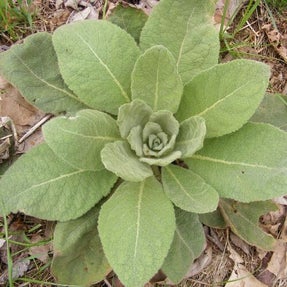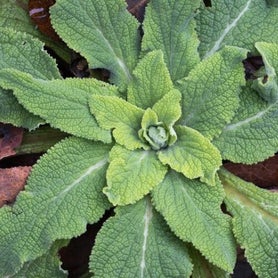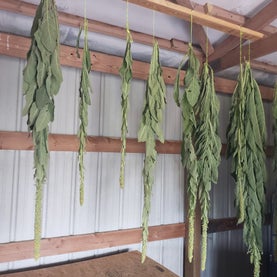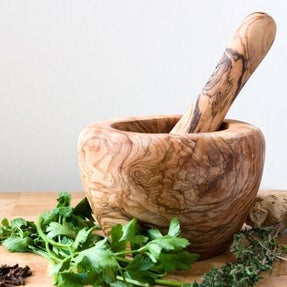
Standing majestically above all other roadside plants is the mighty Mullein. You probably have driven by this plant hundreds of times without even a thought.
But did you know that Mullein has the power to heal! Our ancestors used the leaves to help relieve congestion, soothe coughs, fight inflammation, and more.
In this post, we will explore everything you need to harvest and use this powerful plant.
Fast Facts
- Mullein was imported into the United States in the early 1800s and used for its medicinal properties.
- It is a biennial plant, meaning that it only lives for 2 years.
- Mullein will grow in poor sandy, rocky soils. You will find it mainly by the roadside in Pike County.
- Although it is not native to Indiana, it is not considered a noxious plant.
- The first recorded use was by the Romans, who dipped the leaves in animal fat and used them as torches. It was believed that Mullein torches warded off evil and cleansed your spirit.
Identification

Year 1
Mullein will produce a rosette of leaves that grows close to the ground. These will emerge in the Winter and grow as large as 6 to 7 feet in diameter. The flat, oblong leaves are green-gray in color and are covered in a fuzzy coat. The leaves have no stems and will all attach to a central stem.
During the first year of growth, the leaves are the most potent. The best time to harvest first-year Mullein is either late Fall or early Spring

Year 2
During its second year, the plant will shoot up to heights of 6 or 7 feet. At the end of the stalk will be a flower spike containing small yellow flowers. The leaves will be flat, oblong, and coated in fuzzy spikes.
Although first-year growth is more potent, you can still use Mullein in its second year. It is easier to identify during the second year for first-time users.
For teas, harvest the leaves closest to the top. For poultices and tincture, harvest the top or lower leaves.

DANGEROUS LOOK-ALIKE
Foxglove does not generally grow wild in Indiana. But it is worth noting that the first-year growth of Foxglove does resemble the first-year growth of Mullein. The key to distinguishing between the two is the fuzzy coating Mullein has. Also, Mullein leaf edges will be smoother than Foxglove.
All parts of the Foxglove plant are POISONOUS. Do not consume any parts of a Foxglove plant. If you have any doubts about the differences between Foxglove and Mullein, it is best to pick Mullein in its second year when it develops the tall spike of yellow flowers.
Harvesting and Drying

Whether you are a seasoned pro harvesting first-year plants or a novice beginner harvesting second-year plants, here are some tips to get you going:
- Mullein likes poor, rocky/sandy soil, so your best luck of finding them is near roads. The backroads of Pike are a great place to spot them.
- Wear gloves when handling. The leaves are covered in small spiky hairs.
- Cut Mullein in the hottest part of the day. You want them as free of dew as possible.
- If you are confident that you can identify first-year growth, cut the leaves from the rosette. It is best to cut first-year growth in either late Fall or early Spring.
- When cutting second-year growth, cut down that whole stalk. The top and bottom leaves are suitable for tinctures and poultices. The topmost small leaves are best for teas. Once you start feeling confident in your identification, cut the second-year growth before it flowers for a more potent second-year leaf.
- DO NOT WASH! The tiny fibers in the leaves hold moisture. They will mold easily if you wash them before hanging. This is also why you cut in the hottest part of the day. Brush off dirt, remove bugs, and bad leaves.
- Hang either the whole stalk (upside down) or individual leaves in a warm, dry place that does not get direct sunlight. Garages and barns are great for that. Make sure the plants/leaves have airflow all around them. Your leaves should be dry in about a week or two, depending on the humidity.
- You can also dry the leaves in a dehydrator. First, cut the leaves into small pieces that fit into your dehydrator. Set your dehydrator to 95-100 degrees F and dry for several hours (approximately 4-5, depending on leaf size).
Storing

Once your leaves are thoroughly dried, crumble them up into smaller pieces. Using clean, dry (very important) Mason jars, pack the dried leaves into the jar leaving about a half of an inch headspace. Top with your jar lid and ring. Optionally, you can use a Mason jar vacuum sealer to remove most of the air from the jar.
Store your jars in a cool, dry place and ensure they are not exposed to direct sunlight. Your Mullein should last up to 12 months. If it starts to lose its color, it is no longer good to use.
Medicinal Properties and Studies

Medicinal Properties
- Expectorant: It is suitable for expelling mucus.
- Anti-inflammatory Properties: It is effective in reducing inflammation, especially of the respiratory system (your lungs).
- Demulcent: It creates a soothing coating over the mucus membranes, much like a cough drop.
- Asthma and COPD Use: There are current and ongoing studies that suggest that Mullein can aid in easing asthma and COPD symptoms. While still being studied, people with these conditions should continue their usual medications and consult their doctor before using Mullein.
- Antioxidant: It binds to and protects the cells from free radicals.
- Flavonoids: In addition to being an anti-inflammatory and antioxidant, Mullein contains antibacterial, antiviral, antifungal, and anticancer properties.
- Wound Healing: Because Mullein contains anti-inflammatory, antibacterial, antiviral, and demulcent properties, it has been proven to be very effective in wound healing.

Current and Ongoing Studies
There are several current and ongoing studies that have proven the effectiveness of Mullein. Here are a few that are interesting:
- Neuroprotective properties that have been shown to reduce the presence of Alzheimer's in mice: https://pmc.ncbi.nlm.nih.gov/articles/PMC9003273/
- Anti-inflammatory Study: https://pmc.ncbi.nlm.nih.gov/articles/PMC8301161/#sec5-biology-10-00618
- Antioxidant Study: https://pmc.ncbi.nlm.nih.gov/articles/PMC10297054/#sec4-foods-12-02391
- Antibacterial, Anticarcinogenic, Antimicrobial Study: https://www.mdpi.com/2076-3417/15/6/3254
- Effective against Influenza and Herpes simplex virus type 1: https://pmc.ncbi.nlm.nih.gov/articles/PMC2781767/#sec7
- Shows promise in fighting Tuberculosis: https://pmc.ncbi.nlm.nih.gov/articles/PMC2952292/#sec8
- Wound Healing Study: https://pmc.ncbi.nlm.nih.gov/articles/PMC8186151/#Sec18
- Easing Abdominal Pain: https://pmc.ncbi.nlm.nih.gov/articles/PMC3350428/#sec17
How to Use
Please Read:
Mullein has been labeled as GRAS (Generally Recognized as Safe) by the Food and Drug Administration (FDA). There are several current and ongoing studies regarding its effectiveness. If you have any pre-existing health concerns (especially respiratory or kidney) or are using any types of prescription medications or sedatives, it is always best to consult your doctor before use. Mullein leaves are covered in tiny hairs. Some people may experience irritation of the skin or throat when using. If so, discontinue use immediately. Women who are pregnant or breastfeeding should not use Mullein. Mullein should be used sparingly with children. Always use the recommended and proper dosing for each use. The seeds of the Mullein plant are considered toxic and should not be ingested. If you think you are having any reaction at all to the Mullein, discontinue use immediately and contact your doctor or healthcare provider immediately.

Tea
1 Cup Water, boiling
1 to 2 Tablespoons Dried Mullein Leaves
Honey and Lemon, optional
Mix ingredients in a small bowl and allow to steep for 15 minutes. Using a coffee filter or a 2 to 3 sheets of cheesecloth, layered, strain the tea into a cup or mug. Because the leaves have a fuzzy coating, it is important to strain to reduce throat irritation.
Uses: Coughs and congestion associated with colds, influenza, and other viral infections, asthma relief (consult your doctor first), bronchitis, sore throat and hoarseness, COPD relief (consult your doctor first), stomach aches, sleep aid, skin health such as acne and eczema. While still being studied, it is possible that a cup of tea a day could help to ward off cancer. In addition, since it is an anti-inflammatory, a cup of tea a day may help to alleviate arthritis pain.
Adult Dosing: Begin with 1 cup of tea a day and build your tolerance up to no more than 3 cups a day.
Child Dosing: Although Mullein is considered safe for children, ALWAYS consult your doctor or healthcare provider before giving children under the age of 12 any herbal remedy. A rule of thumb for any herbal tea dosing for children is:
2 to 4 years -- 2 teaspoons
4 to 7 years -- 1 tablespoon
7 to 11 years -- 2 tablespoons
Nutritional Facts: 2 calories per cup and 1 gram of carbohydrates per cup

Poultice
Mullein Leaves, dried
Water
Grind dried mullein flowers and/or leaves into a fine powder. Mix the powder with just enough hot water to create a thick paste. Apply the paste evenly on the affected area.
Cover the poultice with gauze and, if desired, cover the gauze with plastic wrap to avoid messes.
Uses: Due to the tiny hairs on the leaves, before applying a mullein poultice, perform a patch test on a small area of skin to check for any adverse reactions. Otherwise, it can be used on bug bites, minor cuts, and bruising that are not bleeding, skin irritation, inflammation, infections, frostbite, hemorrhoids, splinters, eczema, and engorged breasts.
Adult Dosing: Apply enough to cover the infected area adequately. Reapply as needed and use fresh gauze for each application. Most sites recommend reapplying every 30-60 minutes.
Child Dosing: Although Mullein is considered safe for children, ALWAYS consult your doctor or healthcare provider before giving children under the age of 12 any herbal remedy. Otherwise, you can apply in the same manner as Adult Dosing.
Add comment
Comments